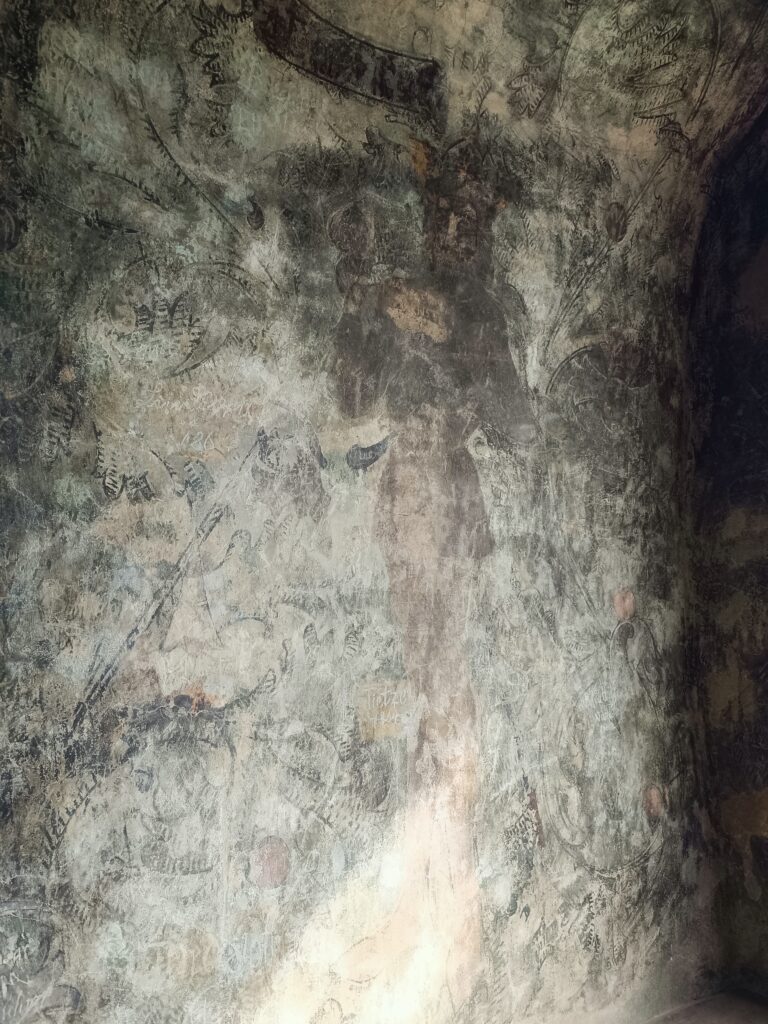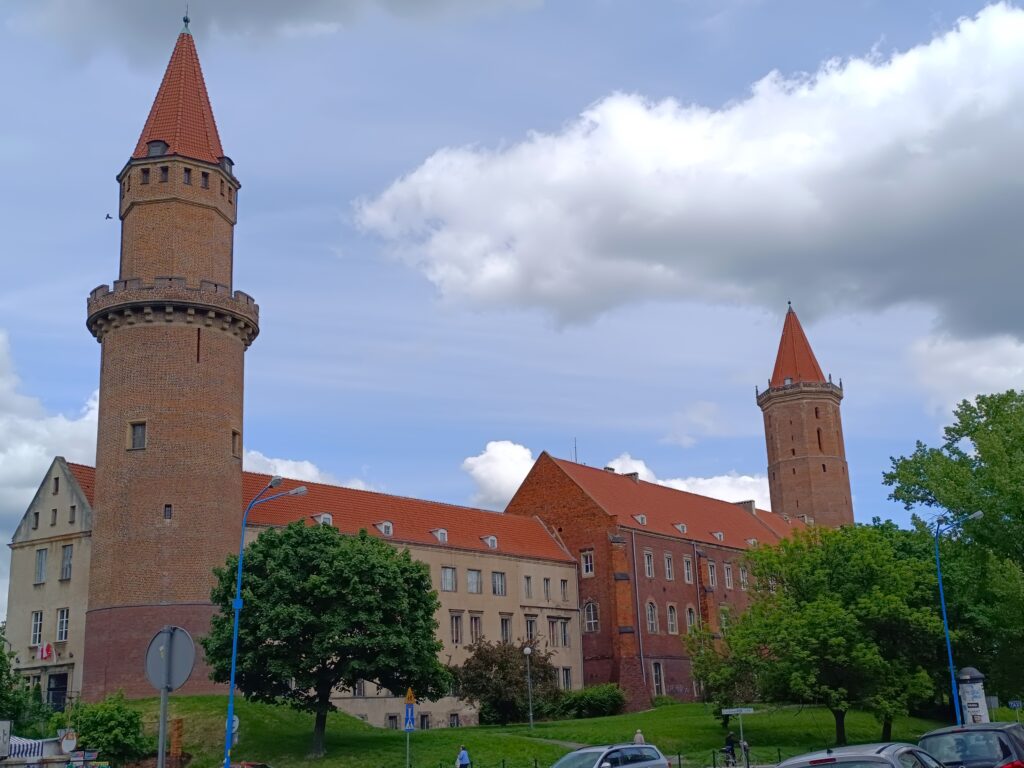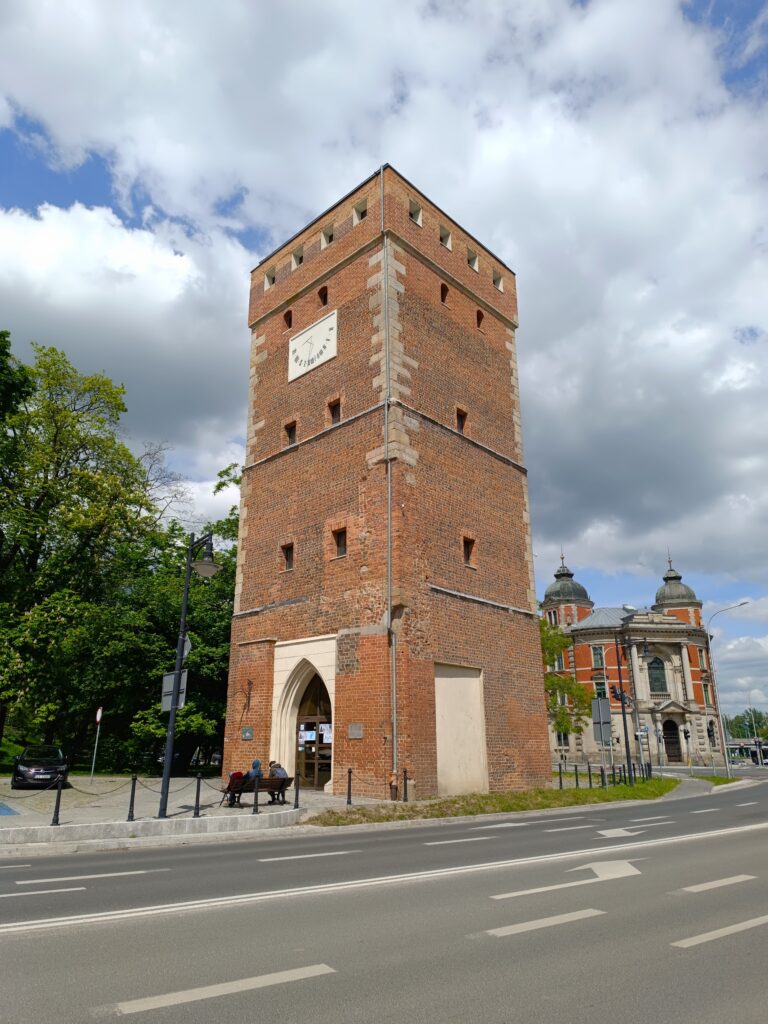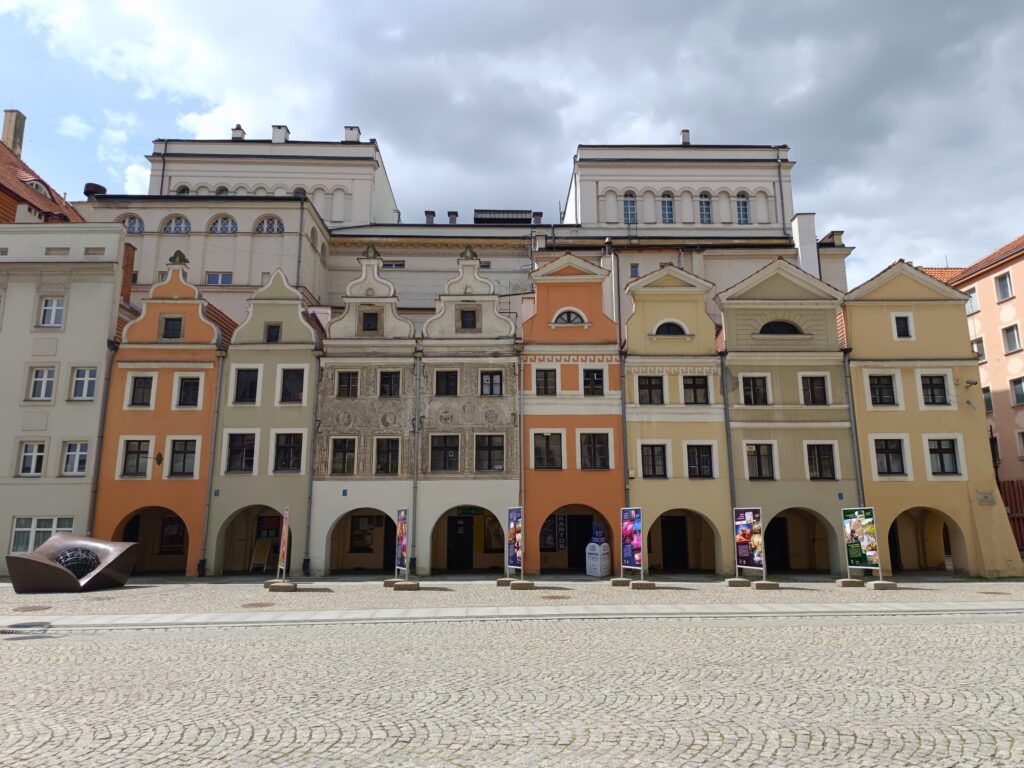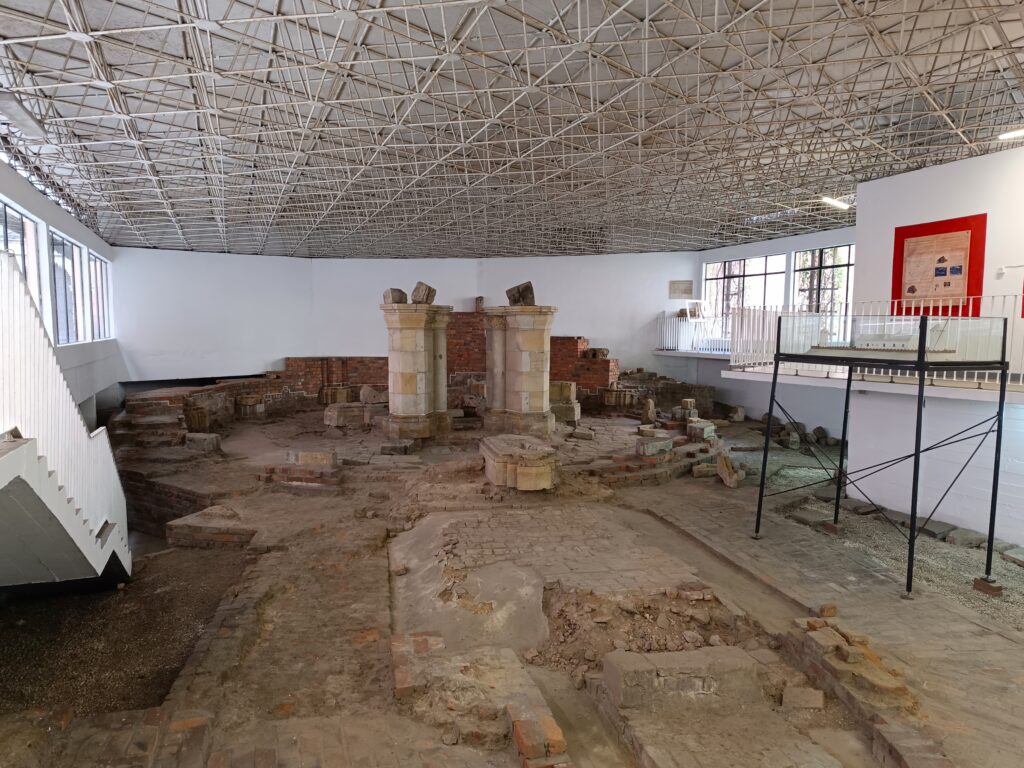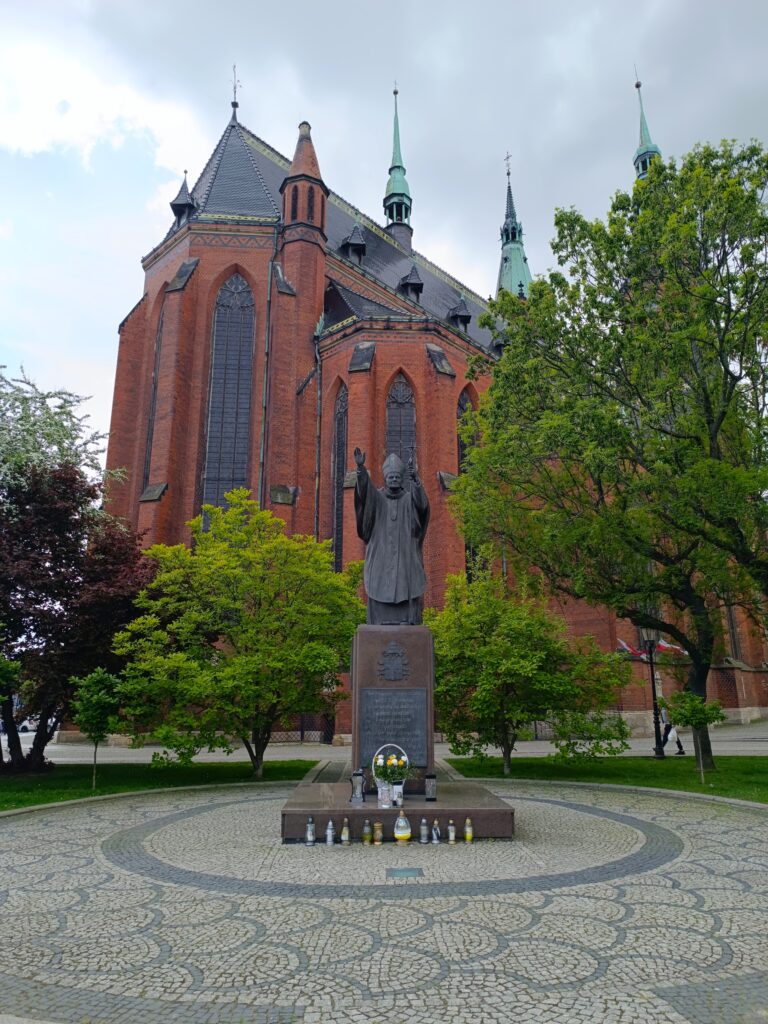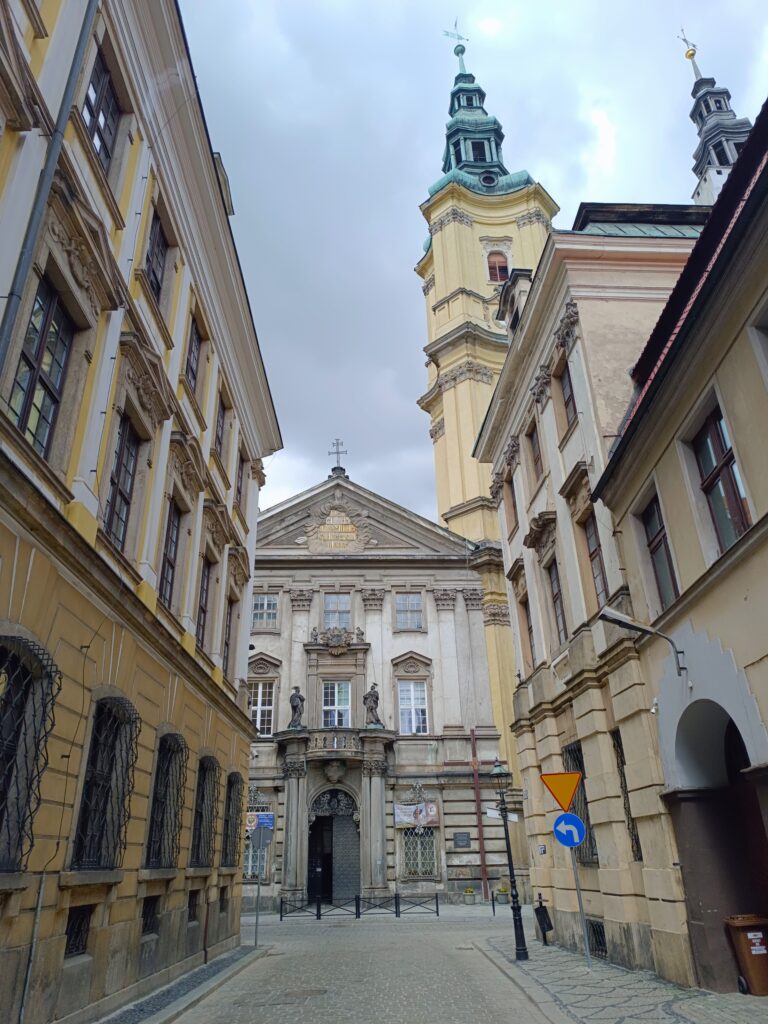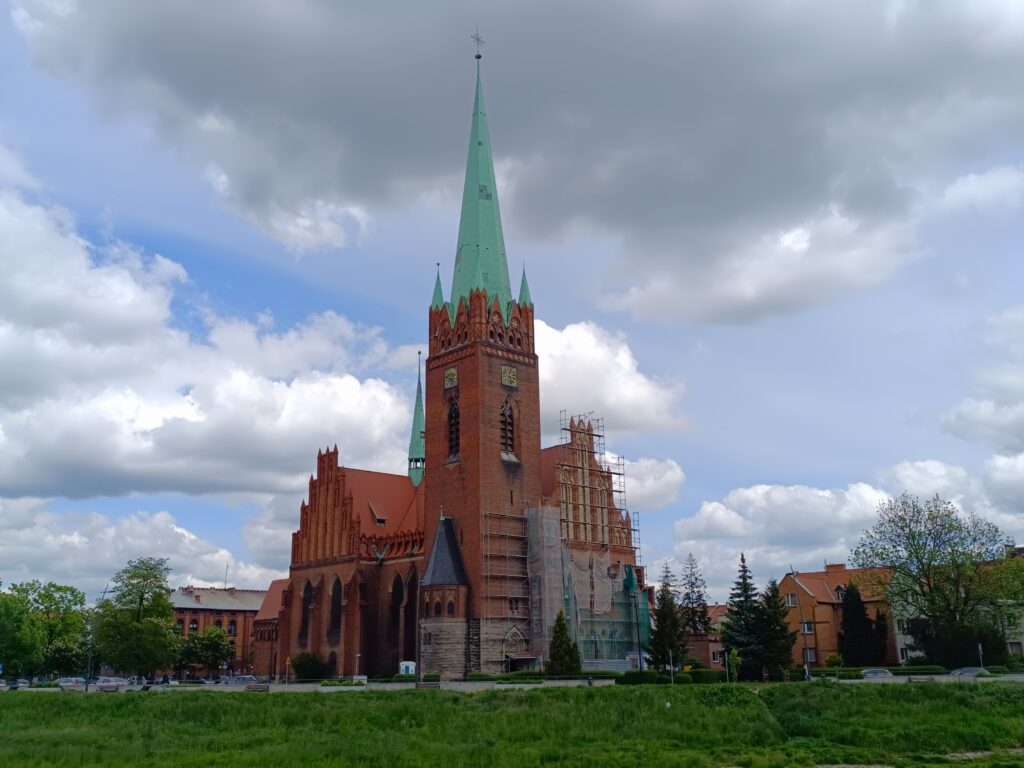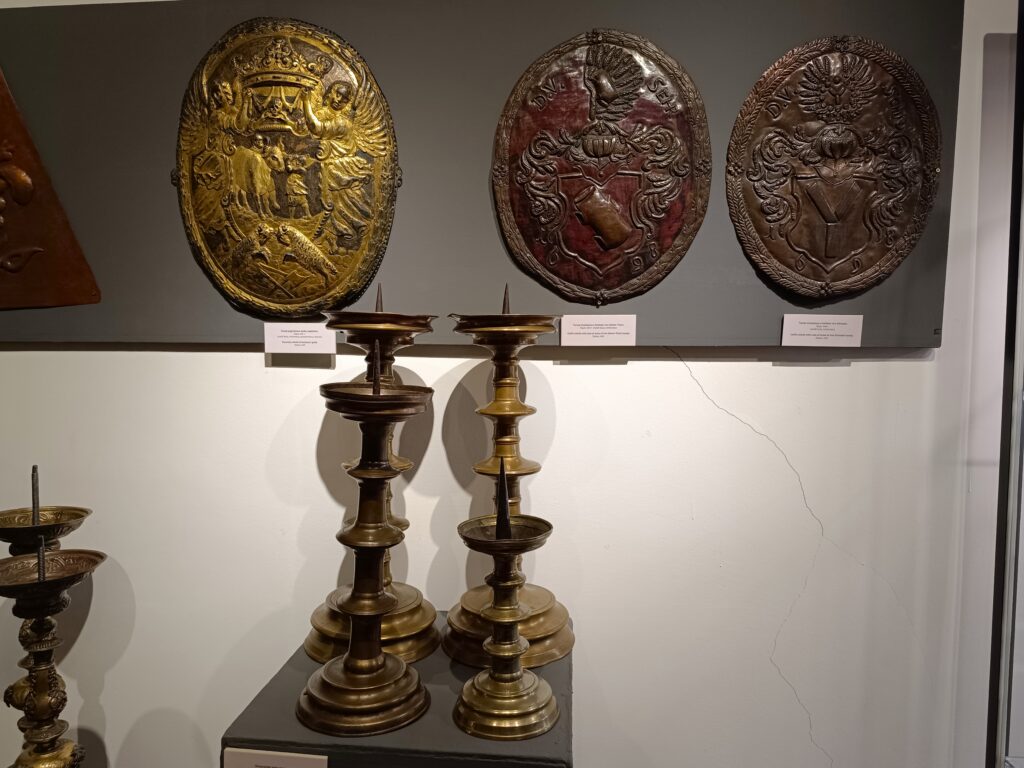All you need to know about the city of
legnica
poland
Sightseeing
Legnica is one of the most fascinating cities in Lower Silesia. The well-preserved market square features ornate townhouses and historic buildings. One of its monumental churches houses a mausoleum where the last Piast ruler was laid to rest, and the Legnica Castle is the second oldest in Poland.
Curiosities
The city is also one of the global centers for copper mining. From medieval times, legends have survived—such as the tale of the starved ghost in the Tower of Saint Peter. In modern times, Legnica has become known as the site of a Eucharistic miracle.
History
It is one of the oldest cities in Poland and also one of the most important in Lower Silesia. The famous Battle of Legnica took place here, and the Duchy of Legnica was ruled by the last of the Piast dynasty. For a long time, the city was a hub of culture and education, as well as—thanks to the Knights' Academy—a symbol of tolerance.
CONTENTS
- The Mysterious Origins of Legnica
- A Piast Stronghold at a Trade Crossroads
- The Beginnings of the Duchy Amid Chaos
- A City of Craftsmanship, Gold, and Bathhouses
- Reunification Under the Banner of Brzeg
- Luther's Followers in the Shadow of the Emperor
- A City Without a Duke, a Duchy Without a Future
- Stagnation Under the Prussian Uniform
- Modernity in the Shadow of the Coming War
- Legnica in the Shadow of Two Empires
SIGHTSEEING
Piast Castle
Admission: 10 PLN
Piast Castle in Legnica is one of the oldest brick castles in Poland. It is even said to be the second oldest structure of its kind in the entire country. Although the interiors are not fully open to visitors—today the castle houses, among other things, a café, a dormitory, and a language school—you can still admire its exterior and explore selected parts of the castle complex.
The castle chapel and the two towers—Saint Peter’s and Saint Hedwig’s—can only be visited with a guide. Tours take place four times a day (at 9:30 AM, 11:30 AM, 1:30 PM, and 3:30 PM), and each lasts about an hour and a half. Notably, admission is free on Wednesdays.
The first stop is the castle chapel—one of the oldest such structures in the city, dating back to the first half of the 13th century. Although little remains of the original interior, a reconstructed layout allows visitors to imagine what the chapel once looked like in its prime.
Access to Saint Peter’s Tower is limited to a designated level—the main attraction isn’t the view, but the Green Chamber. This historic room is decorated with now slightly faded murals depicting legendary and historical figures such as Alexander the Great, Julius Caesar, and King Arthur. Around them, lush greenery blossoms, meant to evoke a vision of a paradise garden.
Visiting Saint Hedwig’s Tower is a different experience. Its lower sections date back to the medieval period. To preserve the original structure, the stairs have been covered with glass platforms, allowing safe access while offering a view of the ancient construction beneath. The upper levels contain rooms that once served the castle’s defenders, and from the very top, you can enjoy a panoramic view of Legnica.
Church of Saint John the Baptist
Admission: Free (Mausoleum: 5 PLN)
The origins of this church date back to the medieval period. Originally built of wood, it was reconstructed in brick in 1294, giving it the form we see today. In the 16th century, the church underwent a significant change—following the Reformation, it became a Calvinist place of worship. During this time, it also took on the role of a burial site, housing the tombs of Legnica’s dukes, and receiving relocated graves of aristocratic families from other churches in the city.
The church’s most important feature is the mausoleum, built in the 17th century. It was constructed for the last members of the Piast dynasty, who are buried here. This mausoleum holds great historical significance—it is the final burial place of the Piast line.
Visits are only possible with a guide, and the meeting point is at the nearby Copper Museum, where tickets must also be purchased. Guided tours last approximately 30 minutes.
Cathedral of Saints Peter and Paul
Admission: Free
The first brick church on this site was built as early as 1225, but the current structure dates back to the 14th century. Its architecture and interior combine elements of Gothic, Baroque, and Neo-Gothic styles, making it one of the most fascinating sacred monuments in the region.
The western portal of the cathedral is adorned with a statue of Mary with the Child, while the northern portal features the Adoration of the Magi—a motif rarely seen in Gothic art. Inside, the cathedral houses valuable relics, including a 13th-century sculpture of Saints Peter and Paul, as well as a 12th-century bronze baptismal font.
As a result of the Reformation, the cathedral was taken over by the Lutherans in the 16th century. In the following centuries, the interior was transformed—Baroque elements were added, and in the 19th century, the cathedral underwent a major Neo-Gothic renovation.
Evangelical Church of Our Lady
Admission: Free (Tower access: 10 PLN regular, 4 PLN reduced)
This is one of the oldest churches in Silesia—its history dates back to the 12th century, when a wooden church was first built on this site. As early as 1192, it was replaced by a more durable stone structure. The church is associated with important historical figures—Saint Hedwig of Silesia prayed here, as did Duke Henry II the Pious before the Battle of Legnica in 1241.
The church suffered severe damage during a fire in the 14th century, which led to a major reconstruction. Further destruction occurred during the Napoleonic Wars, when French troops turned it into a field hospital, causing extensive damage to the interior.
In the 16th century, like many other churches in Silesia, the building was taken over by the Evangelicals. Notably, it remains an Evangelical church to this day—the only one in Legnica to retain its denomination after 1945. At that time, all other Evangelical churches in the city were converted back into Catholic ones.
It’s also worth noting that visitors have the option to climb the church tower and enjoy a panoramic view of the city from above.
Copper Museum
Admission: 20 PLN regular, 10 PLN reduced
The Copper Museum in Legnica is the city’s main museum, dedicated—as the name suggests—to copper. Visitors can explore the history of this raw material, its properties, mining locations, and its importance to the region. The permanent exhibition includes numerous copper-made objects, some of which are several centuries old. The museum also regularly hosts temporary exhibitions, broadening its scope to include art displays and aspects of local history.
A special highlight is the branch of the Copper Museum located in the Knights’ Academy—a historic building that also serves as a major cultural landmark in Legnica. The academy was founded during the Habsburg era as a prestigious noble school. Remarkably, it was open to both Catholic and Protestant students, which was a rare level of religious tolerance for that time.
Today, the Knight’s Academy has been fully restored and serves a variety of purposes. It houses a music school, city offices, a cultural center, and museum space that tells the story of this extraordinary building.
Market Square
Admission: Free
Despite partial destruction during wartime, the Market Square in Legnica still impresses with its many remarkable landmarks. In addition to previously mentioned sites, visitors should take note of the city’s oldest fountains. The first, operating since 1731, features a statue of Neptune. The second, also rebuilt in the same year, is adorned with a sculpture of a Water Maiden.
Another point of interest is the Liebesbrunnen (“Well of Love”)—a former well now surrounded by modern architecture. Nearby are the distinctive Śledziówki Tenement Houses—a row of eight 16th-century buildings decorated in Renaissance, Baroque, and Classicist styles. Also noteworthy is the historic House Under the Quail Basket, which dates from the same era.
The Helena Modrzejewska Theatre, built in 1840, is also located on the square. Even older is the Old Town Hall, constructed in 1741.
Historic Fortifications
Admission: Free
When speaking of Legnica’s former defensive architecture, aside from the castle, two key structures deserve mention. The first is the Głogów Tower, built in the 15th century. Situated within the old city walls, it once guarded the entrance to the city near the former Głogów Gate. The second is the Chojnów Tower, also dating to the 15th century. Though less well-preserved, it stands on the opposite side of the city and serves as another surviving remnant of Legnica’s medieval defense system.
CURIOSITIES
The Story of the Last Piast
The 16th and 17th centuries marked the twilight of the Silesian Piast dynasty—one of the oldest dynastic lines in Europe. As successive branches of the family died out, cities like Opole, Racibórz, and Cieszyn fell under the rule of foreign houses. Yet hope remained for the Duchies of Legnica and Brzeg, where the line still survived. Christian of Legnica, one of the last Piasts, had a son—George William, upon whom rested the expectations of continuing the dynasty.
Given the historical significance of his birth, there were plans to name the boy Piast, after the legendary forefather Piast the Wheelwright. Ultimately, however, he was named George William, earning the title George William of Legnica as the final ruler of the Piast line.
From a young age, the prince received a meticulous education. By his teenage years, he was fluent in German, French, Latin, Italian, Spanish, and Polish—the latter strongly emphasized by his father. His studies also included mathematics, astronomy, physics, philosophy, theology, and rhetoric. He was trained in horseback riding, fencing, and dance, in accordance with the Renaissance ideal of a well-rounded ruler.
After his father’s death in 1672, George William was just 12 years old. The duchy came under the regency of his mother, and the young duke continued his education abroad. He returned to his homeland in 1675, following an audience with Emperor Leopold I of Habsburg, to whom he pledged fealty. At the imperial court in Vienna, he made a strong impression—not only through his noble manners but also his erudition and linguistic skill.
Tragically, his reign was short-lived. Just a few months after his return, he fell ill during a hunting trip. Initially taken to a peasant’s cottage, his condition worsened as he contracted smallpox. He was later moved to Brzeg, where he died on the morning of November 21, 1675, at the age of just 15.
His death marked the end of nearly 700 years of Piast rule. The absence of Polish princes in Silesia accelerated the Germanization of the region’s already predominantly German-speaking towns. Furthermore, both Legnica and Brzeg passed directly under Habsburg control, bringing an end to the political autonomy of the Brzeg–Legnica Duchy.
A Miracle in the 21st Century
Although the Church of St. Hyacinth does not particularly stand out among the region’s historic landmarks, it is associated with an extraordinary story. The church was built in the 20th century in the Neo-Gothic style and was originally dedicated to Emperor Frederick III. During World War II, the building was damaged—some of its decorations were destroyed, and the Red Army used it as a stable. After the war, under Polish administration, the church began to serve as a Catholic place of worship.
The building gained religious significance especially in 2013, when—according to reports—during the distribution of Holy Communion, one of the consecrated hosts fell to the floor. After being picked up, it was placed in a container of water, as per liturgical practice. After some time, the water reportedly turned red. A sample was sent for analysis to the Department of Forensic Medicine, which concluded that it contained tissue resembling heart muscle, with changes typical of a person in agony. Experts identified the material as being of human origin.
The event was recognized by the then Bishop of Legnica, Zbigniew Kiernikowski, as bearing the signs of a Eucharistic miracle.
How the Battle of Legnica Shattered Poland
The 13th century marked the first Mongol invasion in Polish history. Mongol forces advancing from the east ravaged the country, reaching as far as Silesia, where they conquered and burned poorly defended towns.
Facing the invaders stood Duke Henry II the Pious—ruler of Silesia, Kraków, and Greater Poland— upported by knights from Moravia and Germany. It was initially planned that the combined Polish and Czech forces would confront the enemy together, but the rapid pace of the Mongols’ advance made it impossible to unite the armies. Henry was forced to face the invaders alone—on April 9, 1241.
The battle ended in a devastating defeat for the Christian forces. The situation was worsened by the retreat of Henry’s ally, the Duke of Opole and Racibórz. After the knights’ defeat, Henry was captured by the Mongols. According to chroniclers, he refused to pay respects to a deceased Mongol commander and was consequently executed. His severed head was shown to the defenders of Legnica as proof of the Mongol victory.
The death of Henry II the Pious had major political consequences. The duke ruled over three key Polish regions—Silesia, Greater Poland, and Kraków—and was seen as a figure who could reunify a fragmented Poland. His death halted the reunification process, and the period of territorial division continued until the reign of Władysław the Elbow-high in the 14th century.
Secrets of the Legnica Well
A distinctive feature of Legnica’s market square is the Liebesbrunnen—a 17th-century well. It was discovered only in 2009 during revitalization works, and its unearthing caused quite a stir, as it had never been mentioned in any historical sources.
The well is also known as the Lovers’ Well. According to the designers’ concept, couples leaving the civil registry office are encouraged to peer into the well to strengthen their bond. In front of the well, embedded in the pavement, lies a Legnica florin, commemorating the story of a wealthy Hungarian who, 300 years ago, is said to have scattered coins around the square.
The Copper Wealth of Lower Silesia
At the turn of the 19th and 20th centuries, Europe’s demand for natural resources surged dramatically. Copper became one of the most critical raw materials—its global production increased nearly fortyfold within less than a century. After 1945, Poland was not a country rich in resources. Therefore, one of the main tasks of Polish geologists was to identify and locate deposits, with a particular focus on Lower Silesia.
A breakthrough came in 1957, when a series of geological drillings revealed copper-bearing layers. The scale of the deposits turned out to be enormous—it was estimated that tens of millions of tons of copper lay beneath the surface, enough to meet the country’s needs for decades.
This discovery became one of the greatest achievements of Polish geology in the 20th century. To date, over 20 million tons of copper have already been extracted, and it is estimated that at least as much remains underground.
This marked the birth of the Copper Basin—the largest industrial copper mining area in Poland and one of the largest in the world. Its main hub is Legnica, which gained the status of the national center of the copper industry.
The Wailing from the Hunger Tower
Long ago, a young page named Sławek was imprisoned in the Tower of Saint Peter. He was watched over by a knight, Otton von Hohen, who had been tasked with bringing food to the captive. Unfortunately, Otton did not take his duty seriously—he preferred to feast and enjoy himself, quickly squandering the money meant for the prisoner’s meals.
After some time, it was discovered that the page was innocent, and the duke ordered his release. But due to Otton’s negligence, the boy had already died. When the ruler learned of this, he flew into a rage and sentenced the disobedient knight to death by starvation. Otton was locked in the same tower, beside the page’s lifeless body, to suffer the same fate he had inflicted on the innocent.
Otton wailed day and night, begging for forgiveness—in vain. He died after ten days of torment, and his spirit is said to have begun haunting the city. To this day, people claim they can still hear the ghost of Otton wailing from beneath the tower, which has since been known as the Hunger Tower.
The School of Two Faiths
In the late 17th century, Protestantism continued to flourish in parts of Silesia—especially in Legnica, ruled by the Piast dynasty. One of its most fervent supporters was Duke George Rudolf, who established a free secondary school in the city for Protestants, closely tied to the Lutheran Church. Before his death, he provided the school with additional funds and included a prayer in his will, asking God to punish anyone who dared to shut it down.
Unfortunately, after the death of the last Piast of Legnica in 1675, Catholic Habsburgs took power and almost immediately suspended the school’s activities. It wasn’t until 1708 that Emperor Joseph I reopened the institution, transforming it into the Knight Academy—an elite school intended exclusively for noble youth.
This new institution stood out for its time. Although Catholic, it allowed both Catholic and Protestant students to enroll—a rare arrangement in that era. Twelve scholarship spots were created, funded by a Protestant foundation. Of these, seven were reserved for Protestants and five for Catholics. Priority was given to noble families from Legnica, followed by those from all over Silesia. Professors came from across Europe, and students included not only Silesians but also citizens of the Habsburg monarchy and Poles.
The situation changed drastically after the Silesian Wars, when Prussia took control of the region. The new rulers demanded loyalty oaths from the teaching staff, leading many professors to leave. In the years that followed, Protestants and German-speaking students began to dominate. The school’s academic level declined, the number of applicants decreased, and the once-elite Knight Academy was eventually turned into a regular gymnasium. This marked the end of one of the most progressive and religiously tolerant schools in Silesia—and perhaps even in Europe.
The City Under the Soviet Star
After World War II, Legnica played a unique role in the political landscape of Communist Poland—especially from the perspective of its then “ally”, the Soviet Union. It was here that the headquarters of the Northern Group of Forces of the Soviet Army was established, led by Marshal Konstantin Rokossovsky.
Though Soviet troops were responsible for much of the destruction of the city’s buildings, they took over as many as 1,200 properties, amounting to around 30% of Legnica’s pre-war infrastructure. They seized key facilities: schools, hospitals, courts, and administrative offices. Buildings not in use were heavily guarded, and access was strictly forbidden to Polish citizens.
The presence of tens of thousands of Soviet soldiers turned Legnica into a city with limited sovereignty. Decisions regarding urban planning, building heights, investments, and even the appointment of certain local officials had to be approved by the Soviet command.
It’s worth recalling that the stationed troops were not merely defending Poland from the West. In 1956, when Rokossovsky was excluded from the selection of a new Politburo (the highest political organ), he allegedly responded by heading toward Warsaw with a column of tanks. It was also from Legnica that Soviet forces departed in 1968 to suppress the Prague Spring in Czechoslovakia.
Only in 1993 did the last Russian troops leave Legnica. It was only then that many buildings were returned to the city. Restoring them to their former glory was a long and costly process. Thousands of Legnica residents moved into homes that had once been seized by the Soviets.
Due to the scale of Soviet presence, Legnica earned the unofficial nickname Little Moscow—a city that, for decades, resembled a Soviet enclave more than a Polish urban center.
HISTORY
The Mysterious Origins of Legnica
The origin of the name Legnica remains a mystery to this day. The most probable theory suggests it derives from the Old Polish word łę̨g, meaning seasonally wet or marshy land, or river floodplains. Another possibility is the word leg, which means “resting place” or “lair.” An intriguing alternative is that it stems from a Polonized version of Lugh—the name of a Celtic sun god.
There is also an old legend that offers a different explanation. When the brothers Lech and Czech parted ways with Rus, they reached the Odra River region in Lower Silesia. Czech noticed distant mountains and planned to head toward them. Lech offered to accompany him, but Czech considered the journey too dangerous. So they went together only as far as the Odra, where they said goodbye. Lech decided to establish a settlement there and name it after his brother. Czech refused and insisted that the town be named after Lech instead. And so, according to the tale, the medieval city of Lechnica was born.
Another interesting theory links the Roman name Lugidunum to modern-day Legnica. This name appears in Geographia, a manuscript by Claudius Ptolemy. Lugidunum was believed to be a major center of the ancient Lugi tribe. However, since Ptolemy’s manuscript contains geographic inaccuracies, this remains only a hypothesis.
A Piast Stronghold at a Trade Crossroads
The earliest known traces of settlement in the area date back to the 8th century, when it was home to a fortified settlement of the Trzebowian tribe. The region was incorporated into the Polish state by Mieszko I, who ordered the construction of a Piast stronghold there. Soon after, Legnica became an important trading and strategic hub.
Trade routes ran from the German Empire to Kievan Rus, and from Greater Poland to the south. The city’s proximity to the Kingdom of Bohemia and Meissen necessitated its fortification. By the 12th century, Legnica’s status had risen to that of a castellany. Around this time, a stone castle was also built—one of the first of its kind on Polish lands.
In addition to this development, the 12th century in Poland was marked by territorial fragmentation. This period saw the division of the country into smaller duchies, which gradually gained autonomy and, in some cases, near-independence. For Legnica, this meant becoming part of the Duchy of Silesia.
The Beginnings of the Duchy Amid Chaos
The 13th century marked the arrival of a powerful and destructive force from the East—the Mongols. After devastating and subjugating Rus’, they launched their first invasion of Poland. By 1241, the Mongols had reached Silesia, plundering and burning poorly defended towns. The culmination of this campaign was the Battle of Legnica, where Silesian forces, supported by knights from Lesser Poland, Greater Poland, Germany, and Bohemia, attempted to resist the invaders.
The Battle of Legnica ended in a crushing defeat for the Christian armies—Henry II the Pious, Duke of Silesia, Kraków, and Greater Poland, was killed. The consequences of his death went far beyond the Mongol invasion itself. It led to further fragmentation of the Polish state, significantly prolonging the period of feudal division.
By 1248, the first Duchy of Legnica was established. Shortly afterward, Legnica was granted town privileges. Toward the end of the 13th century, the duchy was inherited by Bolesław III the Wasteful, who also ruled Brzeg and Wrocław. Due to his ineffective and extravagant rule, he was forced to share power with his brothers. He took control of Brzeg, his brother Henry became Duke of Wrocław, and the youngest, Władysław, became Duke of Legnica. However, Władysław’s reign was short-lived. After a year of unsuccessful rule, he was deemed mentally unfit and removed from power.
A City of Craftsmanship, Gold, and Bathhouses
For Silesia, the pivotal year was 1327, when nearly all Silesian dukes paid homage to John of Luxembourg, King of Bohemia. This brought Silesia—and Legnica with it—under Czech influence.
However, this did not hinder the city’s development. On the contrary, the 14th century marked a time of dynamic growth for Legnica. Surrounding villages and parts of the Legnica forest were purchased, allowing for territorial expansion of the duchy. Due to its strategic location, the city became a hub of trade, further stimulating its development.
Legnica was encircled by solid city walls, and a brick town hall was erected in the center. Monumental churches were built—St. Peter’s and the Church of the Virgin Mary. Craftsmanship flourished, with the development of cloth and linen dyeing, as well as the opening of waterworks and public bathhouses. A major economic success came with the discovery of gold in a nearby mine, followed by the opening of a mint, which produced Legnica’s first gold coins.
Reunification Under the Banner of Brzeg
Legnica functioned as an independent duchy until 1419, when Wenceslaus II of Legnica was to assume power. However, focused more on his ecclesiastical career, he renounced the throne and transferred power to his cousin from Brzeg—Louis II. This led to the unification of the two duchies, forming the Duchy of Legnica-Brzeg.
Thanks to its strong fortifications, Legnica was able to avoid destruction during the Hussite Wars, which devastated many towns across Silesia. In the 15th century, the city’s coat of arms was changed to the one used today. The earlier version depicted Saint Peter seated with a key in hand, flanked by two towers above the arched battlements of the city wall.
Legnica maintained significant trade relations with the Kingdom of Poland, and many of its citizens studied at the Jagiellonian University. This promoted cultural and intellectual exchange with Kraków.
Luther’s Followers in the Shadow of the Emperor
Legnica experienced true prosperity in the 16th century, following the rise to power of Frederick II, who ushered in the early modern era in the city. In addition to strengthening order in the duchy, Frederick founded a university in Legnica, which unfortunately did not last long. He also established the city’s first printing press, known for its high-quality publications and the use of copperplate engravings.
Frederick was a supporter of Martin Luther’s teachings, leading to the city’s conversion to Protestantism and the secularization of church property. During this time, defensive structures were also expanded due to the growing threat of Turkish invasion.
By the end of the 16th century, tensions across Europe were escalating, particularly between Catholics and Protestants. It was during this period that Legnica once again separated from the Duchy of Legnica-Brzeg, regaining independence. The new ruler, Henry XI of Legnica, soon found himself in conflict with the Habsburgs, who ruled Bohemia and held overlordship over Silesia.
The young duke actively sided with the Protestant cause, held talks with the King of France—a sworn enemy of the Habsburgs—and supported the Huguenots in their struggle in France. However, his actions severely indebted the duchy. Henry XI also refused to pay homage to the new Emperor of Austria, which triggered a military intervention. The duke was captured and imprisoned.
After four years, he escaped, crossing forests and eventually reaching Poland, where he found refuge and support from King Sigismund III Vasa. Soon after, however, Henry XI died under mysterious circumstances. It is suspected that he may have been poisoned—possibly on orders from the Habsburgs.
A City Without a Duke, a Duchy Without a Future
Meanwhile, after Henry XI fled to Poland, his brother assumed power in Legnica. Upon his death, the Duchy of Legnica-Brzeg was reestablished, although the reunification was short-lived. By 1602, the power was once again divided between two brothers. However, dynastic matters soon faded into the background—Europe was on the brink of the Thirty Years’ War, a brutal conflict between Protestants and Catholics over control of the continent.
Legnica attempted to remain neutral during the war—unsuccessfully. The city was first occupied by the Swedes and later seized by the Habsburgs, who maintained control for several years, preventing the return of the local duke to power. To make matters worse, a plague broke out in 1633, claiming the lives of 75% of the city’s population. This devastating disaster brought an abrupt end to Legnica’s era of prosperity.
After the Thirty Years’ War, the Piast dynasty made efforts to restore the city’s former glory. However, the immense human and economic losses severely hindered any significant development.
In 1653, the Duchy of Legnica-Brzeg was reunited for the last time in history. Power was assumed by George IV William, a young and educated ruler who brought hope for the region’s revival. Unfortunately, his reign was cut short by a sudden illness. He died in 1675 without leaving an heir. With his death, the Silesian branch of the Piast dynasty came to an end, and the Habsburg monarchy assumed direct control over the duchy.
Stagnation Under the Prussian Uniform
The early 18th century initially brought a period of development. The city was rebuilding after the disastrous war—serfdom was abolished, agricultural production increased, and with it came improved living standards. Educational institutions also began to emerge, such as the renowned Knights’ Academy. By order of the Habsburgs, churches were being built to support the Counter-Reformation and promote the spread of Catholicism.
However, Legnica did not remain under Austrian rule for long. In 1741, it was taken over by the rising Kingdom of Prussia during the Silesian Wars. Although military operations were taking place around Legnica, the city itself was fortunately spared. After being annexed by Prussia, the duchy was dissolved, and the city ceased to be a major administrative center. This fact, combined with the impact of the Silesian Wars, led to another period of economic stagnation lasting several decades.
In the early 19th century, Legnica again found itself overshadowed by major geopolitical events—this time due to the Napoleonic Wars. Once more, the city avoided significant destruction, but the war negatively affected its economy. However, administrative changes made during this time had a lasting impact on the city’s future — during the occupation, Legnica became the seat of a regional government (Regierungsbezirk), and after Napoleon’s defeat, this status was retained, turning Legnica into an important administrative center in the region.
Modernity in the Shadow of the Coming War
The following decades of the 19th century brought Legnica long-awaited stability and development. Roads were expanded, and in 1844, the first railway connection between Legnica and Wrocław was established. By the 1860s, the city had around 23,000 inhabitants. In response to the needs of the growing community, new schools and hospitals were built, and the streets were illuminated with gas lamps.
However, the real boom came at the turn of the 19th and 20th centuries. The railway network was significantly expanded, leading to the construction of a second train station. A modern water and sewage system and an electric power plant were introduced, allowing the operation of three tram lines. Legnica also became an important center of industrial manufacturing. At the same time, green areas flourished—parks, gardens, and greenhouses were established, and exhibitions of exotic plants and flowers were organized.
Just before the outbreak of World War I, Legnica’s population had grown to around 70,000. Unfortunately, the war once again left its mark on the city’s daily life. Supplies dwindled, a rationing system was introduced, and the quality of life for residents deteriorated significantly.
Legnica in the Shadow of Two Empires
Germany lost the war. This led to significant impoverishment of the population, including in Legnica. In 1935, Hitler came to power. This caused a brief economic revival, the construction of military infrastructure, and the beginning of the persecution of minorities. During World War II, industrial plants were also militarized to maximize the war potential of the Third Reich.
Soviet soldiers entered Legnica in 1945 without encountering much resistance. Nevertheless, even after the fighting had ended in the region, they destroyed the castle as well as several other historic buildings and around three hundred tenement houses. This was due to Soviet authorities allowing several days of “fun” for their soldiers. Legnica was depopulated and became essentially a giant field hospital for wounded Russians.
After the war, the city was incorporated into Poland. The German population was expelled, and Poles from the Eastern Borderlands (Kresy) were resettled in the area. For a brief period, Legnica served as the capital of Lower Silesia, since Wrocław had been too heavily destroyed. During this time, Soviet Marshal Konstantin Rokossovsky demanded that the entire Polish population be relocated to a single district. These forced relocations were compared to the treatment of Jews by the Germans, as only hand luggage was allowed and apartments were seized brutally.
The city began to regain importance in the 1960s, after the discovery of rich copper deposits. This led to a significant industrial expansion, and the population of Legnica started to rise again, surpassing 100,000 in the second half of the 1980s. During this period, a monument to Konstantin Rokossovsky was also erected.
The fall of communism ended the cult of Rokossovsky, whose monument was dismantled. The city became the seat of the Catholic Diocese of Legnica, and by 1993 all Russian soldiers had left. To this day, Legnica remains an important industrial, historical, and cultural center of all Upper Silesia.
Oko na Świat © Artur Gołębiowski

